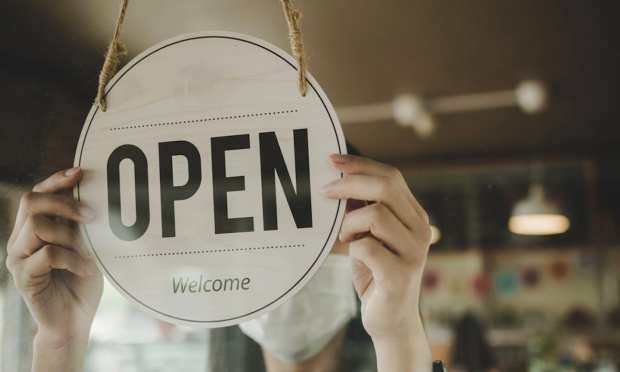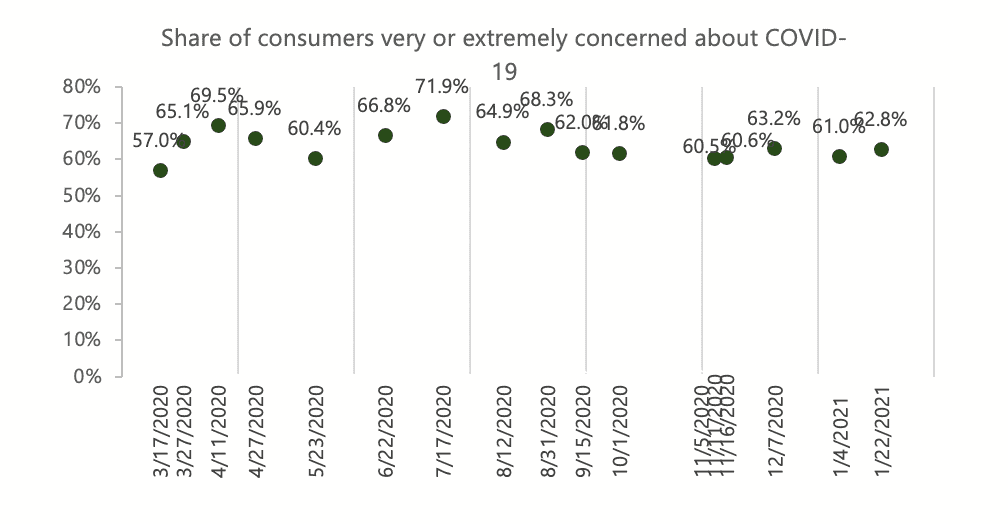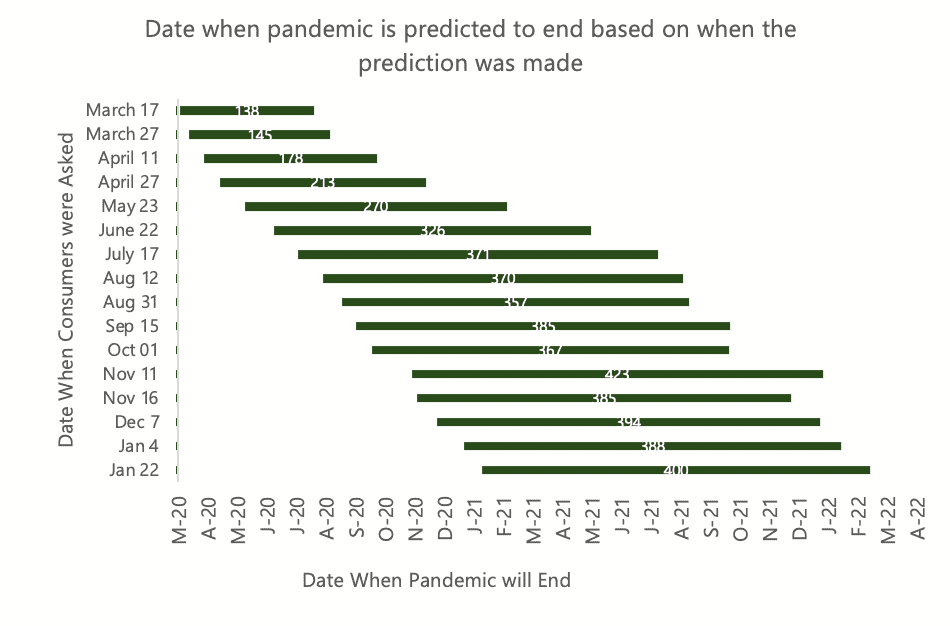Businesses, Consumers On Different COVID Recovery Timetables

With vaccines being rolled out and an end in sight, the temptation is to start whiningly asking “are we there yet?” when it comes to the world getting back to normal. As a growing number of Americans are slowly getting vaccinated and travel passports being perfected, it seems that it’s time to start actively wondering whether the return to dining out and traveling is coming sometime soon.
Unfortunately, according to PYMNTS data, there are a lot of worried consumers out there, expecting that they’ve still got another year of pandemic life ahead of them. Despite the rollout of the vaccine, roughly two-thirds of consumers remain “very” or “extremely” concerned about COVID-19 — consistent with our findings in late 2020. And they are gearing up to wait for a while, with consumers on average predicting a return to normal around February of next year.
 But while consumers are anticipating a long wait, it seems businesses are working with a different calendar. In its earnings call with investors, Uber noted that it was beginning to see evidence that consumers are “ready to get moving again,” and that their efforts are increasingly focused on preparing to meet that ramping demand.
But while consumers are anticipating a long wait, it seems businesses are working with a different calendar. In its earnings call with investors, Uber noted that it was beginning to see evidence that consumers are “ready to get moving again,” and that their efforts are increasingly focused on preparing to meet that ramping demand.
“Over the next six months, we’ll begin to prepare our business to go from preservation mode to reposition. This means investing in new mobility products such as either reserve, rentals, transit, taxis and motorbikes, and rolling out new segmented offerings like Uber Comfort,” CEO Dara Khosrowshahi said, noting that much of this remains contingent on the public health situation improving.
And while NCR wasn’t willing to be quite as specific, they did confirm that internally, they are working with a return-to-normal date expected to occur in 2021. “We’ve declared an end date for the pandemic, but I can’t share it with you,” NCR CEO Michael Hayford noted. “I would say that the parts of the business where consumers have to regain confidence and get out and feel comfortable will be in going to restaurants or going to brick-and-mortar retailers again.”
That growing feeling of confidence among business owners is somewhat mirrored in the world of medicine, where falling infection and death rates are allowing doctors to feel optimism for the first time in several months — tempered by a fair amount of realism. “What we’re seeing is incremental and encouraging, but we’re not out of the woods yet,” Dr. Diane Griffin told NBC.
Case numbers have been on the decline of late, but remain higher than they were during the first wave of infection last spring. There is also a concern that more contagious variations of the virus are spreading more rapidly and could render vaccines less effective. With all of that uncertainty, scientists remain unsure whether the current declines are a real sign of the end approaching, or just a temporary reprieve before another spike.
And looking at PYMNTS data, it seems consumers aren’t very sure or very confident that the end is here, or even coming soon. By the numbers, they are increasingly pessimistic about the pandemic’s duration. When surveyed in early March, consumers on average believed this entire ordeal would be over in under six months — 138 days, to be exact. By March, that number had grown to 270 days; by October, it was 368 days; and by November, it was 423 days. The fact that consumers still expect the pandemic to come to an end by February 2022 is actually a sign of improvement, as this is the first time the estimated timeframe wasn’t extended again.
 And even when “normal” returns, it likely won’t be the old normal. Many of the digital habits discovered during the pandemic are likely to stick around even after the physical world fully reopens for business. A significant share of consumers will continue to practice caution when it comes to engaging with the outside world. PYMNTS’ survey data indicates that 43.4 percent will leave their homes as much as they do now, whereas 52.4 percent would leave their homes either more often or much more often once a vaccine is available to them.
And even when “normal” returns, it likely won’t be the old normal. Many of the digital habits discovered during the pandemic are likely to stick around even after the physical world fully reopens for business. A significant share of consumers will continue to practice caution when it comes to engaging with the outside world. PYMNTS’ survey data indicates that 43.4 percent will leave their homes as much as they do now, whereas 52.4 percent would leave their homes either more often or much more often once a vaccine is available to them.
Normal will return someday — though perhaps not in the form to which we are all accustomed. After so many months of daily disruption, consumers have become new, in a sense — and they are looking for a new normal.
